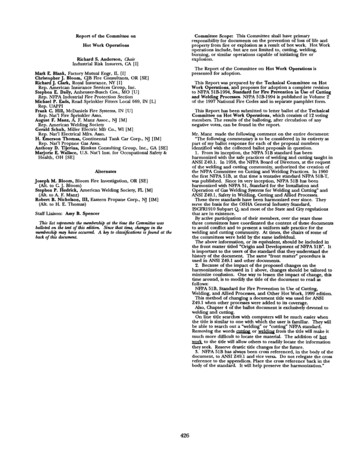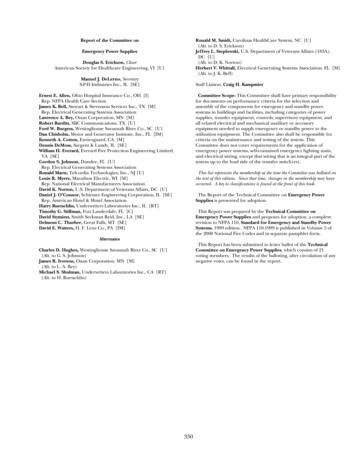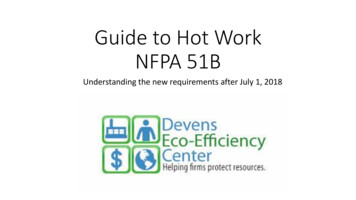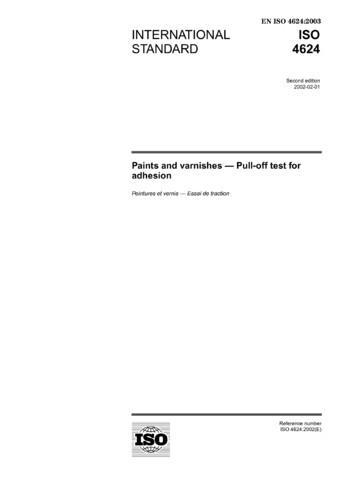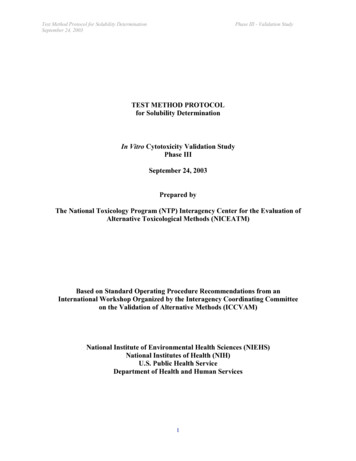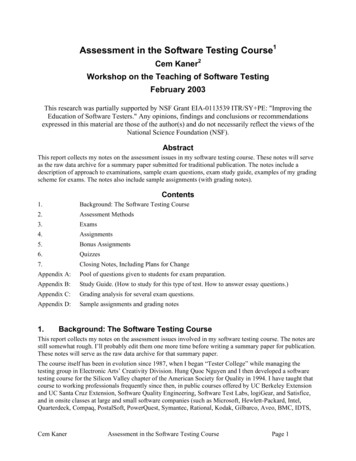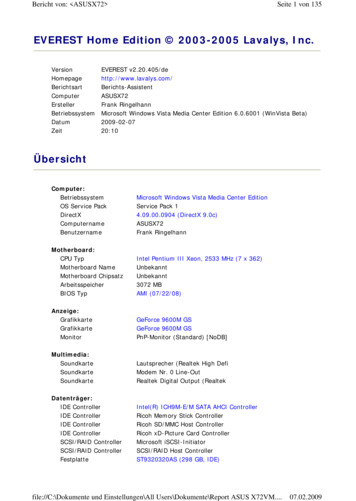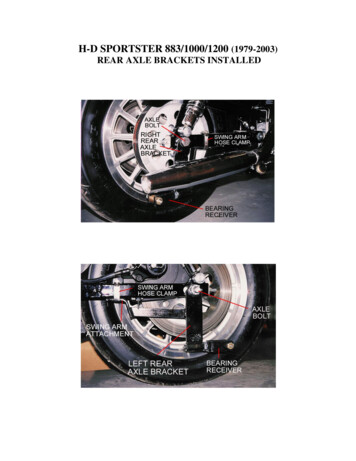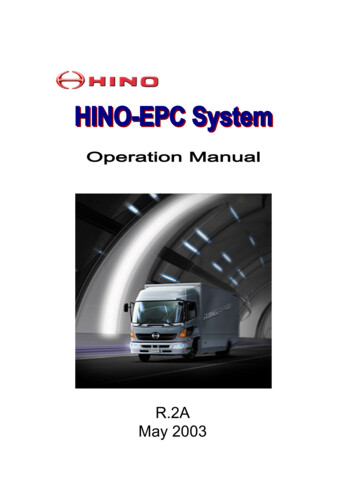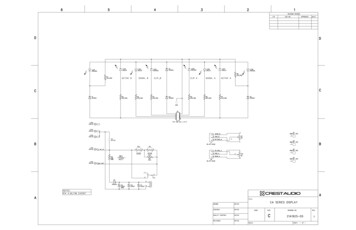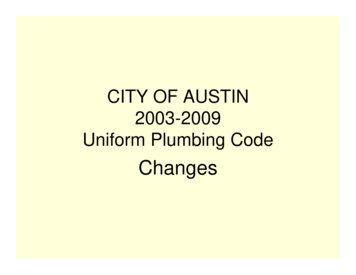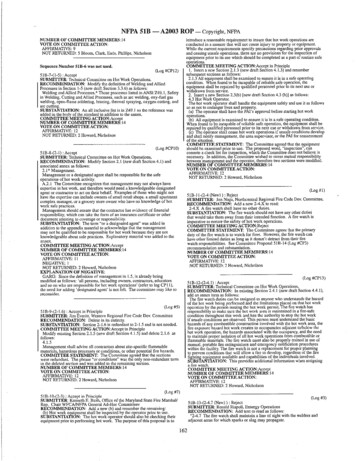
Transcription
NFPA 51B — Copyright, NFPANFPA 51BThe retroactive requirements of this standard shall be permitted to bemodified if their application clearly would be impractical in the judgment ofthe authority having jurisdiction, and only where it is clearly evident that areasonable degree of safety is provided.Standard forFire Prevention During Welding, Cutting, and Other Hot Work2003 EditionNOTICE: An asterisk (*) following the number or letter designating aparagraph indicates that explanatory material on the paragraph can be foundin Annex A.A reference in brackets [ ] following a section or paragraph indicatesmaterial that has been extracted from another NFPA document. As an aid tothe user, Annex C lists the complete title and edition of the source documentsfor both mandatory and nonmandatory extracts. Editorial changes to extractedmaterial consist of revising references to an appropriate division in thisdocument or the inclusion of the document number with the division numberwhen the reference is to the original document. Requests for interpretationsor revisions of extracted text shall be sent to the appropriate technicalcommittee.Information on referenced publications can be found in Chapter 2 and AnnexC.Chapter 1 Administration1.1 Scope.1.1.1* This standard shall cover provisions to prevent loss of life and propertyfrom fire or explosion as a result of hot work.Chapter 2 Referenced Publications2.1 General. The documents or portions thereof listed in this chapterare referenced within this standard and shall be considered part of therequirements of this document.2.2 NFPA Publications. National Fire Protection Association, 1Batterymarch Park, P.O. Box 9101, Quincy, MA 02269-9101.NFPA 25, Standard for the Inspection, Testing, and Maintenance ofWater-Based Fire Protection Systems, 2002 edition.TINNFPA 51, Standard for the Design and Installation of Oxygen–Fuel GasSystems for Welding, Cutting, and Allied Processes, 2002 edition.NFPA 55, Standard for the Storage, Use, and Handling of Compressedand Liquefied Gases in Portable Cylinders, 1998 edition.NFPA 241, Standard for Safeguarding Construction, Alteration, andDemolition Operations, 2000 edition.2.3 Other Publications.2.3.1 ANSI Publication. American National Standards Institute, Inc., 11West 42nd Street, 13th floor, New York, NY 10036.ANSI Z49.1, Safety in Welding, Cutting, and Allied Processes, 1999.RPE1.1.2 Installation and operation of arc cutting and welding equipment andoperation of gas cutting and welding equipment shall be in accordance withANSI Z49.1, Safety in Welding, Cutting, and Allied Processes.1.2 Purpose. This standard shall provide guidance for persons, includingoutside contractors and property managers, who manage, supervise, andperform hot work.1.3 Application.1.5 Equivalency. Nothing in this standard is intended to prevent the use ofsystems, methods, or devices of equivalent or superior quality, strength, fireresistance, effectiveness, durability, and safety over those prescribed by thisstandard. Technical documentation shall be submitted to the authority havingjurisdiction to demonstrate equivalency. The system, method, or device shallbe approved for the intended purpose by the authority having jurisdiction.RPChapter 3 Definitions3.1 General. The definitions contained in this chapter shall apply to theterms used in this standard. Where terms are not included, common usageof the term shall apply.1.3.1 This standard shall apply to the following hot work processes:(1) Welding and allied processes(2) Heat treating(3) Grinding(4) Thawing pipe(5) Powder-driven fasteners(6) Hot riveting(7)* Torch-applied roofing in conjunction with the requirementsof NFPA 241, Standard for Safeguarding Construction, Alteration, andDemolition Operations(8) Similar applications producing a spark, flame, or heat.3.2 NFPA Official Definitions.3.2.1* Approved. Acceptable to the authority having jurisdiction.3.2.2* Authority Having Jurisdiction (AHJ).The organization, office, or individual responsible for approving equipment,materials, an installation, or a procedure.3.2.3 Shall. Indicates a mandatory requirement.3.2.4 Should. Indicates a recommendation or that which is advised but notrequired.1.3.2 This standard shall not apply to the following:3.2.5 Standard. A document, the main text of which contains onlymandatory provisions using the word “shall” to indicate requirements andwhich is in a form generally suitable for mandatory reference by anotherstandard or code or for adoption into law. Nonmandatory provisions shall belocated in an appendix or annex, footnote, or fine-print note and are not to beconsidered a part of the requirements of a standard.(1) Candles(2) Pyrotechnics or special effects(3) Cooking operations(4) Electric soldering irons(5) Design and installation of gas cutting equipment and weldingequipment covered in NFPA 51, Standard for the Design and Installation ofOxygen–Fuel Gas Systems for Welding, Cutting, and Allied Processes(6) Additional requirements for hot work operations in confined spaces(7) Lockout/tagout procedures during hot work1.4 Retroactivity. The provisions of this standard reflect a consensus of whatis necessary to provide an acceptable degree of protection from the hazardsaddressed in this standard at the time the standard was issued.Unless otherwise specified, the provisions of this document shall not apply tofacilities, equipment, structures, or installations that existed or were approvedfor construction or installation prior to the effective date of the standard.Where specified, the provisions of this standard shall be retroactive.In those cases where the authority having jurisdiction determines thatthe existing situation presents an unacceptable degree of risk, the authorityhaving jurisdiction shall be permitted to apply retroactively any portions ofthis standard deemed appropriate.3.3 General Definitions.3.3.1 Designated Area. A permanent location designed or approved for hotwork operations.3.3.2 Hot Work. Work involving burning, welding, or a similar operationthat is capable of initiating fires or explosions.3.3.3 Management. For the purpose of hot work, all persons, includingowners, contractors, educators, and so on, who are responsible for hot workoperations.3.3.4 Permit. A document issued by the authority having jurisdiction for thepurpose of authorizing performance of a specified activity. [1:2.1]3.3.5* Permit Authorizing Individual (PAI). The individual designated bymanagement to authorize hot work.3.3.6* Welding and Allied Processes. Processes such as arc welding, oxy–fuel gas welding, open-flame soldering, brazing, thermal spraying, oxygencutting, and arc cutting.1
NFPA 51B — Copyright, NFPAChapter 4 Responsibility for Hot Work4.4.6 The fire watch shall watch for fires in all exposed areas and try toextinguish them only when the fires are obviously within the capacity ofthe equipment available. If the fire watch determines that the fire is notwithin the capacity of the equipment, the fire watch shall sound the alarmimmediately.4.4.7* The fire watch shall be permitted to have additional duties, but dutiesshall not distract them from their fire watch responsibilities, except asoutlined in Chapter 6.4.5 Mutual Responsibility. Management, contractors, the PAI, the firewatch, and the operators shall recognize their mutual responsibility forsafety in hot work operations.4.1* Management. Management or a designated agent shall be responsiblefor the safe operations of hot work activity.4.1.1 Management shall establish permissible areas for hot work.4.1.2 Management shall designate a permit authorizing individual (PAI).4.1.3 All equipment shall be examined to ensure it is in a safe operatingcondition.4.1.4 When found to be incapable of reliable safe operation, the equipmentshall be repaired by qualified personnel prior to its next use or withdrawnfrom serviceChapter 5 Fire Prevention Precautions4.1.5 Management shall ensure that only approved apparatus, such astorches, manifolds, regulators or pressure-reducing valves, and acetylenegenerators, are used.5.1 Permissible Areas.5.1.1 General. Hot work shall be permitted only in areas that are or havebeen made fire safe.5.1.2 Designated or Permit-Required Areas. Hot work shall be performedin either designated areas or permit-required areas.4.1.6 Management shall ensure that all individuals involved in the hot workoperations, including contractors, are familiar with the provisions of thisstandard.5.1.2.1 Designated Areas. A designated area shall be a specific areadesigned or approved for hot work, such as a maintenance shop or a detachedoutside location that is of noncombustible or fire-resistive construction,essentially free of combustible and flammable contents, and suitablysegregated from adjacent areas.4.1.6.1 Individuals involved in hot work operations shall be trained in thesafe operation of their equipment and the safe use of the process.4.1.6.2 Individuals involved in hot work operations shall have an awarenessof the inherent risks involved and understand the emergency procedures inthe event of a fire.4.1.7 Management shall advise all contractors about site-specific flammablematerials, hazardous processes or conditions, or other potential fire hazards.4.2 Permit Authorizing Individual (PAI). In conjunction with management,the PAI shall be responsible for the safe operation of hot work activities.TIN5.1.2.2 Permit-Required Areas.5.1.2.2.1 A permit-required area shall be an area that is made fire safe byremoving or protecting combustibles from ignition sources.5.1.2.2.2 Signs shall be posted designating hot work areas as deemednecessary by the PAI.5.2* Nonpermissible Areas. Hot work shall not be permitted in the followingareas:(1) In areas not authorized by management(2) In sprinklered buildings where sprinklers are impaired, unlessthe requirements of NFPA 25, Standard for the Inspection, Testing, andMaintenance of Water-Based Fire Protection Systems, are met(3) In the presence of explosive atmospheres (that is, where mixtures offlammable gases, vapors, liquids, or dusts with air exist)(4) In the presence of uncleaned or improperly prepared drums, tanks,or other containers and equipment that have previously contained materialsthat could develop explosive atmospheres(5) In areas with an accumulation of combustible dusts that coulddevelop explosive atmospheresRPE4.2.1 The PAI shall determine site-specific flammable materials, hazardousprocesses, or other potential fire hazards that are present or likely to bepresent in the work location.4.2.2 The PAI shall ensure the protection of combustibles from ignition bythe following means:(1) Moving the work to a location that is free from combustibles(2) If the work cannot be moved, moving the combustibles to a safedistance or have the combustibles properly shielded against ignition(3) Scheduling hot work so that operations that could exposecombustibles to ignition are not begun during hot work operationsRP4.2.3* If the criteria of 4.2.2(1), (2), or (3) cannot be met, hot work shallnot be performed.4.2.4 The PAI shall determine that fire protection and extinguishingequipment are properly located at the site.5.3* Hot Work Permit.4.2.5 Where a fire watch is required (see Section 5.4), the PAI shall beresponsible for ensuring that a fire watch is at the site.5.3.1* Before hot work operations begin in a nondesignated location, awritten hot work permit by the permit authorizing individual (PAI) shall berequired.4.2.6* Where a fire watch is not required, the PAI shall make a final check1/ hour after the completion of hot work operations to detect and2extinguish smoldering fires.5.3.2 Before a hot work permit is issued, the following conditions shall beverified by the PAI:(1) The hot work equipment to be used shall be in satisfactory operatingcondition and in good repair.(2) Where combustible materials, such as paper clippings, woodshavings, or textile fibers, are on the floor, the floor shall be swept clean for aradius of 11 m (35 ft) and the following criteria also shall be met:(a) Combustible floors (except wood on concrete) shall be kept wet,covered with damp sand, or protected by noncombustible or fire-retardantshields.(b) Where floors have been wet down, personnel operating arcwelding equipment or cutting equipment shall be protected from possibleshock.(3)* All combustibles shall be relocated at least 11 m (35 ft) in alldirections from the work site and the following criteria also shall be met:(a) If relocation is impractical, combustibles shall be protected withfire-retardant covers or otherwise shielded with metal or fire-retardantguards or curtains.(b) The edges of covers at the floor shall be tight to prevent theentrance of sparks, including at the point at which several covers overlapwhere a large pile is being protected.(4) Openings or cracks in walls, floors, or ducts within 11 m (35 ft)of the site shall be tightly covered with fire-retardant or noncombustiblematerial to prevent the passage of sparks to adjacent areas.(5) Ducts and conveyor systems that might carry sparks to distantcombustibles shall be shielded or, shut down, or both.4.3 Hot Work Operator. The hot work operator shall handle equipmentsafely and use it as follows so as not to endanger lives and property:(1) The operator shall have the PAI’s approval before starting hot workoperations.(2) All equipment shall be examined to ensure it is in a safe operatingcondition, and, if found to be incapable of reliable safe operation, theequipment shall be repaired by qualified personnel prior to its next use orwithdrawn from service.(3) The operator shall cease hot work operations if unsafe conditionsdevelop and shall notify management, the area supervisor, or the PAI forreassessment of the situation.4.4 Fire Watch.4.4.1* The fire watch shall be trained to understand the inherent hazards ofthe work site and of the hot work.4.4.2 The fire watch shall ensure that safe conditions are maintained duringhot wor
NFPA 25, Standard for the Inspection, Testing, and Maintenance of Water-Based Fire Protection Systems, 2002 edition. NFPA 51, Standard for the Design and Installation of Oxygen–Fuel Gas Systems for Welding, Cutting, and Allied Processes, 2002 edition. NFPA 55, Standard for the Storage, Use, and Handling of Compressed
